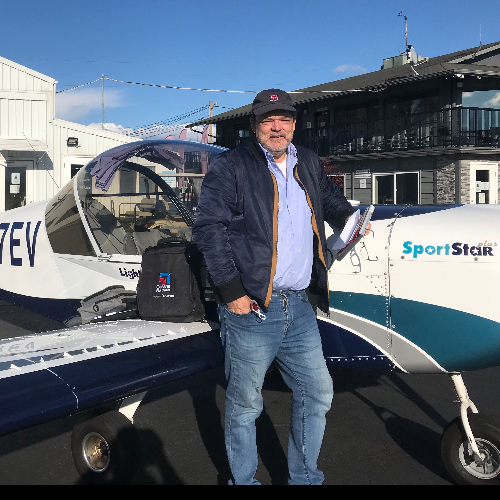Introduction:
Alaska Airlines Flight 261 crashed into the ocean off the coast of California on Jan. 31, 2000, when the jackscrew assembly in the tail of the aircraft failed, causing the aircraft to lose vertical control.
The pilots fought valiantly to the very last second to save their flight, but their fate was sealed by circumstances set in place long before they ever boarded the aircraft.
This is the second of two parts. Part 1 can be found here: https://aeroxplorer.com/articles/extraordinary-courage-the-fight-to-save-alaska-air-flight-261.php
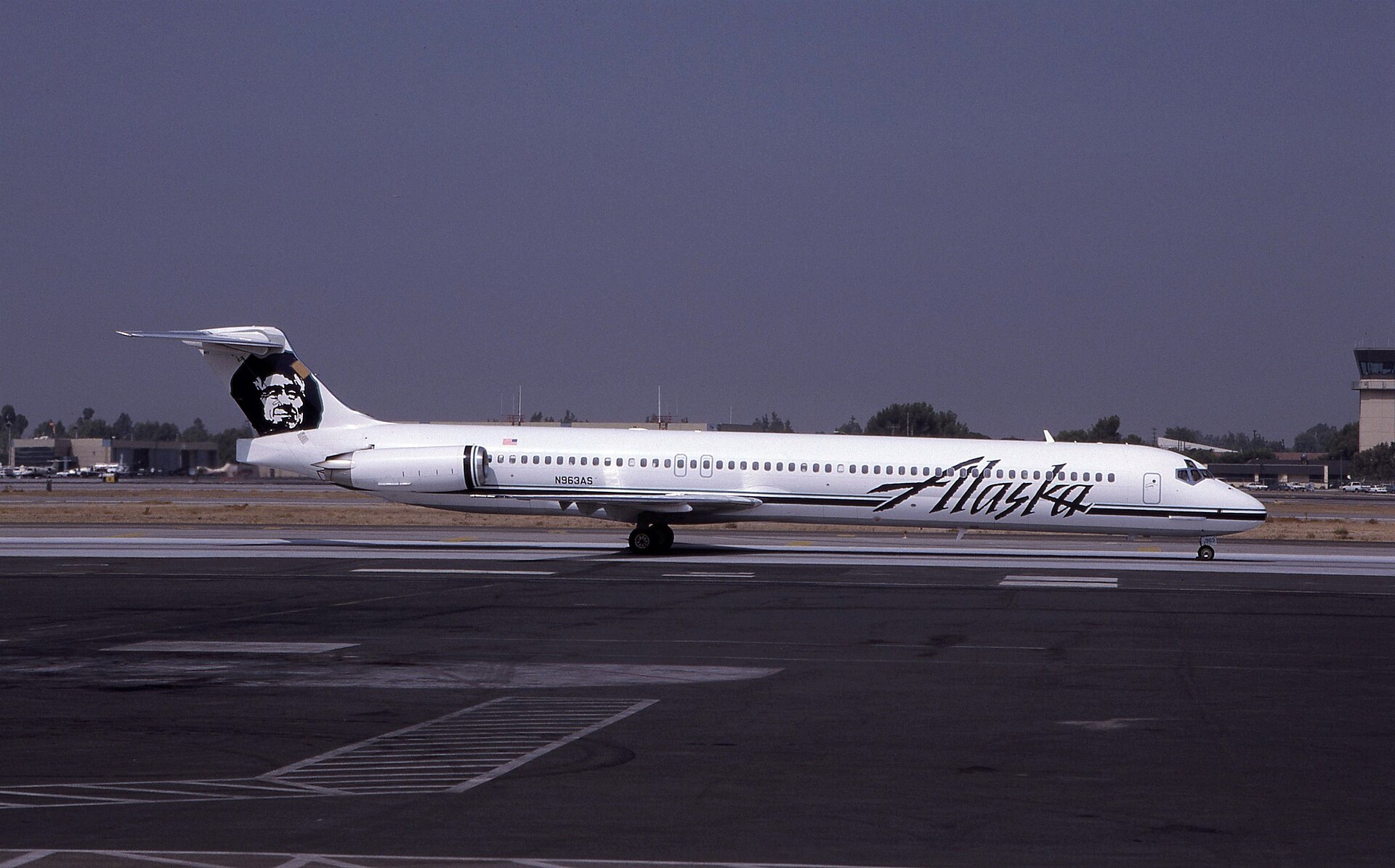
The moment Captain Thompson thumbed the pickle switches and grabbed ahold of the suitcase handle control to move it forwards and backwards, the autopilot disengaged and the MD-83's nose plunged toward the earth.
There was the sound of a clunk that seemed to come from behind the aircraft, followed by two thumps in short succession. The horizontal stabilizer-in-motion audible tone sounded.
“Holy Sh*t!” Tansky exclaimed.
“You got it? F*** me!” Thompson reacted.
“What are you doing!”
“It clicked off — It got worse!”
What the two pilots couldn’t have known was that the jack screw had run completely through the acme nut as its threads failed. The only thing holding the physical assembly together now was the metal stopper at the bottom of the screw. The vertical stabilizer had also run to the full limit of its travel in the nose-down position. The airframe of the aircraft began to vibrate.
“You’re stalled,” Captain Thompson advised, mistaking the vibration for the stick shaker stall warning. The vibration became louder.
“No, no, you gotta release it, ya gotta release it,” he reacted to Tanksy’s pulling back on the yoke as the plane nosed over.
“Let’s [try the] speedbrake. Gimme high pressure pumps.”
“OK.”
“Help me back, help me back!”
“OK.”
Realizing they were not actually stalling, the pilots of flight 261 worked together to pull the yoke up to arrest their descent. It would take more than 130 pounds of back pressure.
Knowing they were diverting from the assigned altitude in a hurry, Captain Thompson alerted air traffic control.
“Center, Alaska two sixty-one. We are, uh, in a dive here. And I’ve lost control, vertical pitch.”
The clacker and the “Overspeed” voice warning sounded for the next 33 seconds.
“Alaska two sixty-one, say again sir,” LAX ARTCC responded.
“We’re out of twenty-six thousand feet, we are in a vertical dive… not a dive yet... but, uh, we’ve lost vertical control of our airplane.”
Thompson spoke with both his copilot and ATC over the next few seconds.
“Just help me,” he asked Tansky.
“Once we get the speed slowed, maybe… we’ll be ok.”
Then to Thompson spoke to ATC, “We’re at twenty-three seven, request, uh … Yea, we got it back under control here.”
Simultaneously, ATC could hear the copilot protest in the background. “No we don’t.”
“The altitude you’d like to, uh, to remain at?” ATC asked.
The two pilots continued the struggle to regain control of their aircraft.
“Let’s take the speed breaks off,” Tansky suggested.
“No, no, leave them there. it seems to be helping. It really wants to pitch down. Don’t mess with that.”
“I agree with you,” Tansky concluded.
“Alaska two sixty-one, say your condition,” LAX called. It had been 36 long seconds since they last heard from the plane.
“Two sixty-one. We are at twenty-four thousand feet, kinda stabilized. We’re slowing here, and uh, we’re gonna do a little troubleshooting. Can you gimme a block between uh, twenty and twenty-five?”
ATC cleared Flight 261 to use any altitude between 20 and 25 thousand feet that they needed. Captain Thompson accepted this and advised ATC that they would be monitoring the frequency, and continued to work the problem out with his copilot.
“You have the airplane, let me just try it,” Tansky asked, meaning he wanted to feel the pressures on the control column for himself while Thompson continued to act as the pilot-flying. “How hard is it?”
“I don’t know, my adrenaline’s goin’…It was really tough there for a while.” Captain Thompson noted
“Yea, it is … Whatever we did is no good, don’t do that again.” stated Tansky
“Yea, no. It went down. It went to full nose down.”
“Uh, it’s a lot worse than it was?”
“Yea, yea, we’re in much worse shape now.”
Captain Thompson was beginning to sense the extent of the problem.
“I think it’s at the stop, full stop… and I’m thinking, can it go any worse… But it probably can… But when we slowed down … Let’s get down to two hundred knots and see what happens.”
“We have to put the slats out and everything,” Tansky advised. “Flaps and slats.”
“Yea ... well, we’ll wait. OK, you got it for a second?”
“Yea.”
Captain Thompson radioed LAX Maintenance again. This time, they could hear two voices on the other end. Thompson confirmed that trying both the pickle switches and the suitcase handles resulted in a runaway nose down trim.
Then he added, “… and I’m afraid to try it again to see if we can get it to go in the other direction.”
“OK, well, your discretion, uh, if you want to try it, that’s ok with me,” Maintenance responded. “If not, that’s fine. We’ll see you at the gate.”
Maintenance seemed completely oblivious to the dire situation in the air.
The two pilots also discussed the option of trying the trim switches again in the opposite direction. In normal operation, thumbing the pickle switch upwards should cause the nose to head down, while pressing the switch downward should cause the nose to rise.
“Did it happen in reverse?” Tansky asked. “When you pulled back it went forward?”
“I went tab-down… and it should have come back [up]. Instead, it went the other way.”
“Uh huh.”
“What do you think?”
“Uhhh …”
“You wanna try it, or not?”
“Uhh, no! Boy, I don’t know.”
“It’s up to you, man.”
“Lets head back toward, uh … Here, let’s see…” Tansky was suggesting they head back to the airport in Los Angeles immediately.
At this point, Captain Thompson was forced to make one of those choices no pilot in command ever wants to be in a position to make. Nonetheless, Thompson made the decision courageously in full awareness of their situation.
Knowing that the controllability of his aircraft was in doubt, he elected to continue their flight over the ocean. Were they to completely lose control over the crowded Los Angeles metropolitan area, there could be untold damage done on the ground.
“I like where we’re going, out over the water, myself,” he shared with First Officer Tansky. “I don’t like going this fast, though.”
“We better talk to the people in the back there,” Tansky reminded Thompson of the flight attendants and passengers. The MD-83 had plunged for a full 80 seconds at a rate of 6,000 feet per minute, far exceeding anything a passenger would experience in normal flight.
Captain Thompson clicked on the public address system to address the passengers. “Folks, we have had a flight control problem up front here. We’re working it. That’s Los Angeles off to the right there. That’s where we’re intending to go. We’re pretty busy up here working this situation. I don’t anticipate any big problems once we get a couple of sub systems on the line. But we will be going into LAX and I’d anticipate us parking there in about twenty to thirty minutes.”
Then the pilots immediately turned to evaluating the controllability of the airplane.
“OK … First of all, speedbrakes,” Thompson began. “Did they have any effect? Let’s put the power where it’ll be for landing. You buy that? Slow it down and see what happens.”
At this point, Los Angeles Air Route Traffic Control handed Flight 261 over from one sector to another, requiring a frequency change. Thompson took the yoke so Tansky could handle the radio communication.
The new sector cleared them “Direct Santa Monica, Direct Los Angeles.” Given their position almost directly perpendicular to the airfield by now, this would be the shortest and most expeditious route to safety on the ground.
“Center, Alaska two sixty-one. I need to get down about ten [thousand feet], change my configuration, make sure I can control the jet,” Thompson informed ATC. “And I’d like to do that out here over the bay, if I may.”
“OK, Alaska two sixty-one, roger that. [We’ll] standby here.”
“Let’s do it at this altitude instead of going to ten,” Tansky suggested.
“I just made a PA to everyone to get everybody down. You might call the flight attendants,” Capt. Thompson said.
“OK.”
Within seconds, the cockpit door opened and one of the flight attendants — either Kristin Mills or Allison Shanks — came into the cockpit. “I was just coming up this way.” one of the flight attendants said.
“I need everything picked up,” Thompson told her. “and everybody strapped down. ‘Cause I’m gonna unload the airplane and see if we can regain control of it that way.”
“OK. We had like a big bang back there,” she informed the crew.
“Yea, I heard it,” Thompson replied.
“You heard it in the back?” Tansky asked.
“Yea. I didn’t wanna call you guys… but they’re, like, you better go up there and tell them.”
“No, no, that’s good,” Thompson assured her. “I need you to get everybody strapped in now, dear. ‘Cause I’m going to release the back pressure and see if I can get it... back.”
The flight attendant left and the door shut behind her.
LAX ARTCC cleared Flight 261 to 17,000 feet.
“I don’t think you want any more speedbrakes, do you?” Tansky asked.
“Uhh, no, actually. OK, I need help with this here. Gimme slats extend.”
“Got it.”
Tansky moved the slats handle to extend the leading edge devices on the front of the wings.
“I’m test flyin’ now —” Capt. Thompson said.
“How does it feel?”
“It’s wanting to pitch over more on you.”
“Really?”
“Yea.”
“Try flaps?… fifteen, eleven?”
“Ahh, let’s go to eleven.”
Tansky moved the flap handle to eleven degrees. “OK... Get some power on,” he advised. It was standard practice to add some power when flaps are deployed.
“I’m at two hundred and fifty knots, so I’m lookin….” Thompson was concerned about their airspeed. Normally, flaps aren’t extended until the MD-83 is almost 100 knots slower than it was at this point in flight.
“Real hard?” Tansky asked about the airplane’s handling.
“No, actually it’s pretty stable right here... But we got to get down to a hundred an eighty … OK… Bring the flaps and slats back up for me.”
“Slats, too?”
“Yea.”
Thompson explained his next plan of action. “What I wanna do... is get the nose up... and then let the nose fall through and see if we can stab it when it’s unloaded.” He was still hoping he could free the stabilizer of whatever was jamming it.
“You mean use this again?” Tansky referred to the pickle switch and suitcase handles. “I don’t think we should... If it can fly, it’s like … “
“It’s on the stop now, it’s on the stop.” Thompson was assuming the horizontal stabilizer had gone as far in the nose-down position as it physically could. However there was an indicator in the cockpit that, erroneously, may have led the pilots to believe otherwise.
A pipper on a rounded scale on the center pedestal measured the degrees of nose-up or nose-down trim. It had frozen at 0.4 degrees nose down at the very beginning of the problem, then moved to all of three degrees nose-down when the jackscrew let go. That put the pipper slightly beyond the highest number on the indicator’s scale.
“Well, not according to that, it’s not. The trim might be, and then it might be if something’s popped back there — it might be mechanical damage too.”
Tansky had assumed correctly that the problem went beyond the electrical motors driving the trim system, and lied with something physically broken in the assembly of the MD-83's horizontal stabilizers.
“I think if it’s controllable, we oughta just try to land it,” Tansky added.
The captain pondered this thought for exactly two seconds. “You think so? OK, let’s head for LA.”
Just five seconds later, the jack screw assembly failed completely. The screw had come completely out of the acme nut, and the horizontal stabilizer was now completely free from any means of controlling it. The pilots heard thumps coming from the back of the airplane.
“You feel that?” Tansky asked with alarm.
“Yea. OK gimme sla --- see, this is a b***h!”
“Is it?”
“Yea!”
Tansky moved the slat and flaps controls again.
The force required to pull back on the yoke was now unmanageable. The angle of the stabilizer was now an untenable 3.7 degrees nose-down. So strong were the aerodynamic forces on the stabilizer that the fairing at the top of the vertical tail broke away from the airplane as the leading edge of the horizontal stabilizer rammed its way upwards to an angle too high to be measured by the Flight Data Recorder.
The noise of rushing air around the fuselage caused by the increased airspeed began to fill the pilots’ hearing. Loose items normally held in place by gravity began to tumble around the cockpit. The MD-83 was rolling over on its back.
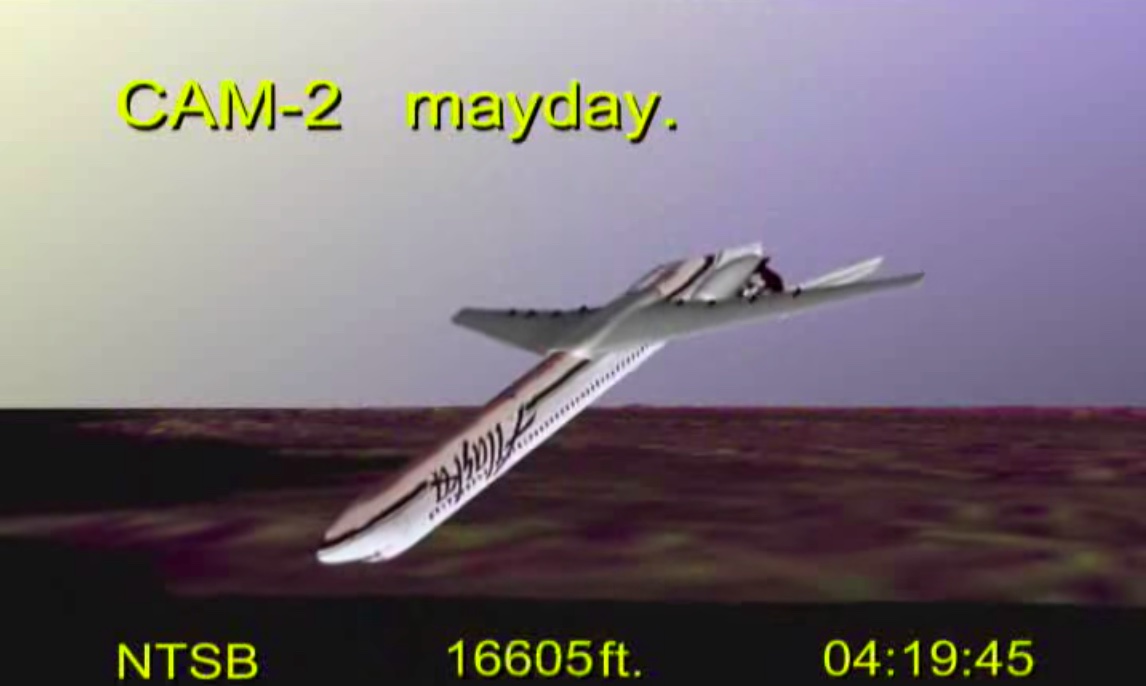
“Mayday!” Tansky called out to no one, as he was not transmitting over the radio.
“Push and roll, push and roll,” Thompson ordered. He wanted to roll the plane over to counteract the nose-down pitch of the stabilizer. The crew retracted the flaps.
“OK, we are inverted... and now we gotta get it….”
A chime sounded.
“Kick!” Thompson continued. “Push, push, push ... push the blue side up!”
“I’m pushing,” Tansky responded.
“OK, now let’s kick rudder... Left rudder! Left rudder!”
“I can’t reach it.”
By this point, the airplane has been upside down for 40 seconds. Both pilots’ bodies would be dangling on their safety harnesses and shoulder straps, or perhaps pushed out of position by centrifugal forces.
“OK, right rudder... Right rudder … Are we flyin’?... We’re flyin’... We’re flyin’... Tell ‘em what we’re doin’.”
“Oh yea let me get …”
“Gotta get it over again ... At least upside down we’re flyin’.”
Flight 261 had now been inverted for a full minute, during which what began as a 70 degree nose-down dive had been reduced to a 29 degree nose-down inverted dive, and finally to a nine degree descent while still upside down. From the viewpoint of the two pilots, the Pacific Ocean filled the part of the windscreen where the sky usually appeared.
In another ten seconds, there was the sound of compressor stalls. In essence, the disruption of airflow to one of the engines was causing it to blast out the front end. This was followed immediately by the engines of the MD-83 aircraft power spooling down.
“Speedbrakes,” Capt. Thompson requested.
“Got it,” Tansky responded.
By now, the damaged MD-83 aircraft was just too close to the surface of the water to be recovered.
“Ah! Here we go!” Captain Thompson exclaimed.
One second later, Alaska Air Flight 261 slammed into the ocean. The aircraft was destroyed by the force of impact.
A week later, the two-foot-long jackscrew was recovered from the seafloor at the crash site, broken completely free of the acme nut. Strands of metal, like hair, were found coiled around it; that was all that was left of the grooves inside the acme nut after being stripped out if it.
Captain Thompson and First Officer Tansky were posthumously awarded the Air Line Pilots Association Gold Medal for Heroism for the courageous manner in which they fought to control their airplane until the very last moments. However, the fate of the crew and passengers of Flight 261 was sealed by circumstances beyond their control, long before they took off on that sunny day from Puerto Vallarta.
In memory of those who lost their lives that day.
The Most Turbulent Flights in the World » COMAC: Destined for Failure or Success? » Is Sustainable Aviation Fuel a Viable Option to Replace Jet Fuel? »
Comments (0)
Add Your Comment
SHARE
TAGS
STORIES alaska airlines md-83 lax pvr los angeles air disaster plane crashRECENTLY PUBLISHED
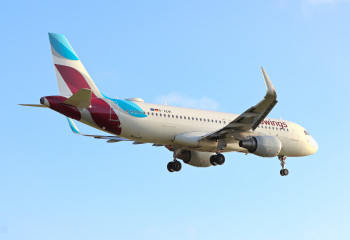 The Most Turbulent Flights in the World
Turbulence is a common phenomenon experienced on flights all across the world. However, factors such as weather that greatly influence turbulence are more prevalent in certain areas than others. This begs the question: are certain flights more prone to turbulence than others? The short answer is yes and many factors lead up to this. As such, today we will examine these factors and which air routes are the world's most turbulent.
ROUTES
READ MORE »
The Most Turbulent Flights in the World
Turbulence is a common phenomenon experienced on flights all across the world. However, factors such as weather that greatly influence turbulence are more prevalent in certain areas than others. This begs the question: are certain flights more prone to turbulence than others? The short answer is yes and many factors lead up to this. As such, today we will examine these factors and which air routes are the world's most turbulent.
ROUTES
READ MORE »
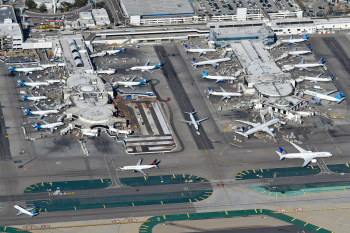 How Flight Trackers Make Flying Safer
Integrating biometric validation, facial recognition, automated visa processing, ticketing, and boarding, coupled with ADS-B and ASDE-X, has evolved aviation security, ensuring a safe and secure travel experience.
INFORMATIONAL
READ MORE »
How Flight Trackers Make Flying Safer
Integrating biometric validation, facial recognition, automated visa processing, ticketing, and boarding, coupled with ADS-B and ASDE-X, has evolved aviation security, ensuring a safe and secure travel experience.
INFORMATIONAL
READ MORE »
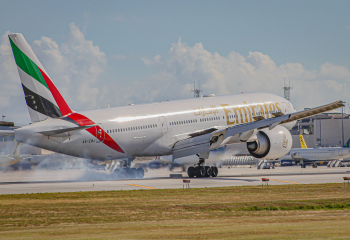 The Story of the Forgotten Emirates A340 Fleet
The Airbus A340 is a long-range, wide-body passenger airliner that was developed and produced by Airbus. In the mid-1970s, Airbus developed the A340 quadjet. The A340-300 took its maiden flight on 25 October 1991. It was certified along with the A340-200 on 22 December 1992 and both versions entered service in March 1993 with launch customers Lufthansa and Air France. The larger A340-500/600 were launched on 8 December 1997; the A340-600 flew for the first time on 23 April 2001 and entered service on 1 August 2002.
NEWS
READ MORE »
The Story of the Forgotten Emirates A340 Fleet
The Airbus A340 is a long-range, wide-body passenger airliner that was developed and produced by Airbus. In the mid-1970s, Airbus developed the A340 quadjet. The A340-300 took its maiden flight on 25 October 1991. It was certified along with the A340-200 on 22 December 1992 and both versions entered service in March 1993 with launch customers Lufthansa and Air France. The larger A340-500/600 were launched on 8 December 1997; the A340-600 flew for the first time on 23 April 2001 and entered service on 1 August 2002.
NEWS
READ MORE »




